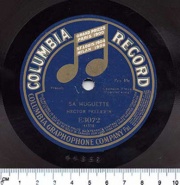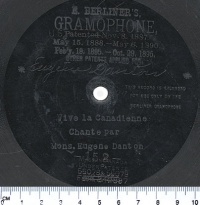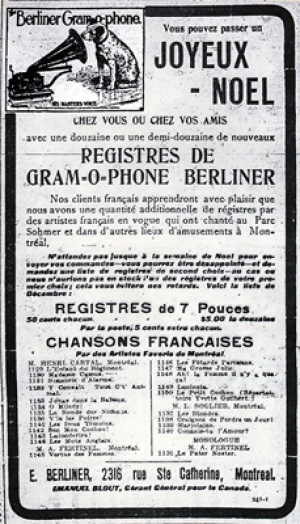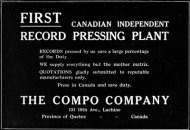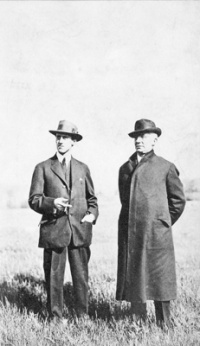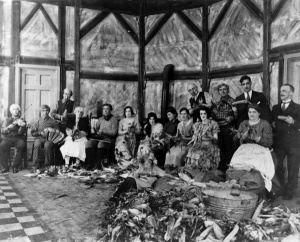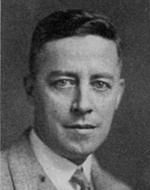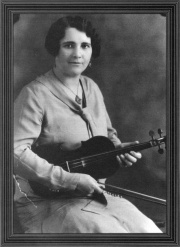First Recordings of Popular Songs in French Canada
par Bouliane, Sandria P.
Vinyl recordings of French-Canadian songs were first produced at the turn of the 20th century. While Anglo-American music dominated all the markets, social and cultural factors such as the massive migration of French Canadians to the United States and the appearance of music specifically intended for the various ethnic groups that were immigrating to the U.S. fostered the recording of popular songs in French. It is often forgotten that the effervecent Roaring Twenties preceding the Great Depression of the 1930s gave birth to the Quebec recording industry. In fact, during the 1920s, recordings of French-Canadian singers produced in Montreal proliferated and were a smashing success.
Article disponible en français : Débuts de la chanson populaire enregistrée au Canada français
The Birth of the French-Canadian Audio Tradition
The tradition of the French-Canadian recording industry expanded rapidly during the 1896-1921 period, which began with the very first commercial recordings (NOTE 1) and ended with the initial large-scale distribution of French-Canadian records. By this time, aesthetic choices based on language, traditions and history were already determining the style and distinct cultural characteristics of French-Canadian recordings.
The Beginnings of Commercial Production in the French Language: 1896-1902
However, is it possible to determine who performed the first piece of music recorded in the French language? After consulting numerous phonographic recording lists,(NOTE 2) it seems that, in 1896, Maurice Farkoa recorded the songs "Au Clair de la Lune" and "Le Fou Rire" for the Washington D.C.-based Berliner Gramophone Company (BGC). That same year, BGC recorded an aria from the operetta Les cloches de Corneville, sung by the soprano Laura Libra and the following year, a certain Robert Villiars performed five American songs translated into French for the New York-based Columbia Graphophone company.(NOTE 3)
The very first recording of a French-Canadian artist took place around 1898-99 when BGC received the singer Eugène Danton at its New York studios, where he recorded works from the French-language folk repertoire, including "À la claire fontaine," "Vive la Canadienne," "En roulant ma boule" and "C'est la belle Françoise." Danton initiated the slow process of developing a Canadian recording industry that was actually started up in the United States, since no recording studios existed in Canada at that time. In spite of the fact that "French-Canadian" recordings were produced only occasionally, there was a growing, genuine interest in French-Canadian artists, which was probably linked to the massive migration of Canadian workers to New England. In fact, from 1890 to 1930, approximately 32 percent of Quebec's population (over 450,000 inhabitants) crossed the border in order to find work in the industries of the Northern United States. Before radio became an accessible medium toward the middle of the 1920s, vinyl recordings were a treasured source of cultural reassurance for the diaspora cut off from their culture, which often served as the only remaining souvenirs of their oral tradition.
An American Production of "Ethnic" Music in the French Language: 1903-1916
In order to be recorded, the first Canadian artists had to travel to Camden, [N.J.], New York, London, or Paris. Nevertheless, during the 1903-04 period, Herbert Berliner, the son of the owner of BGC, decided to produce a few recordings in Montreal. It was during this exceptional year that the Montreal-based Berliner Gram-O-phone Company produced the first recordings on Canadian soil. Of the nearly 300 French language recordings intended for the French-Canadian market that were produced in the United States and Canada between 1898 and 1908, the vast majority featured artists of French origin (Henri Cartal, A. Fertinel, Emile Mercadier, Victor Occellier, etc.) rather than Canadians (with the exception of L. Loiseau and Joseph Saucier).
A little before 1910, the first so-called "ethnic" recordings appeared on the musical scene. Qualified as "ethnic records" at the time, this music included anything not in the classical or English language repertory of popular song (including show music, Tin Pan Alley (NOTE 5) and Vaudeville). Record companies took advantage of this labelling to integrate into their catalogues a list of pieces in the French language-and whenever possible, some from French Canada.
So it was that between 1908 and 1923, Columbia Records created its E-series, or General Ethnic series, recording a few French-Canadian artists along with artists from France. BGC, however, introduced its HMV series for the Canadian market toward the end of 1909, selecting artists of French origin likely to interest Canadian buyers. Following in its footsteps, the Edison company produced the Amberol and Blue Amberol labels between 1912 and 1915, which also included French and French-Canadian artists. And so, one can generally say that, before 1916, French-language music recordings produced in North America were done in New York, with Canadian performers representing a tiny minority of the recording artists.
From New York to Montreal: Establishing an Increasingly Distinct Canadian Identity
Around 1915, Columbia Records, under the auspices of Roméo Beaudry (1882-1932), reserved a selection from its catalogue for a French-Canadian artists. While Columbia was inviting artists to its New York studios, Berliner Gramophone resumed its Montreal recording sessions that it had abandoned in 1904. Of the nearly 800 titles produced in Canada between 1916 and 1918, fewer than 90 were the work of French-Canadian artists. Nevertheless, this first entirely French-language recording and production would hereafter be carried out only in Canada. Furthermore, the resulting record sales to the general public was enough to convince the record companies that it would be worth their while to repeat the offer very soon.
In 1918, Herbert Berliner was the project manager for BGC's Canadian series, and he decided to launch a new Montreal-based HMV series, this time exclusively reserved for French-Canadian artists. No fewer than 500 French-language record titles were produced between 1918 and 1929. During that same year, Berliner also founded the Compo Company, in order to offer a record-pressing service for a number of independent companies. One of Compo's first contracts was pressing record labels for the American Starr Piano Company, for which Roméo Beaudry had been appointed director of French-language production. The summer of 1920 was marked by the launching of an exclusively French-language series, of which nearly all the titles were recorded by French Canadians.
From 1918 on, recording in Montreal and giving priority to the province's French-language artists became standard practice. The regular production of French-Canadian recordings was a necessary step in the creation of a culturally representative phonographic repertory. At Compo, the company offices, the recording studio, the artists and the pressing plant were all in close proximity, making it easier to increase local production at a productive rhythm that Robert Thérien describes as follows: "The [Starr] 12000 series was launched in June 1921 and led to the production of 37 recordings by Quebec artists in six months, an output equalling Columbia's, and exceeding that of HMV's 263000 series [...]. In 1923, Beaudry became the uncontested leader of the French-language market, producing more Franco-Quebec recordings than Columbia and HMV combined."(NOTE 6)
The Emergence of the French-Canadian Popular Song
The beginning of the First World War marked a key moment in the production of ethnic recordings. In 1916, the production and transportation of merchandise from Europe came to an abrupt halt. As a result, recordings in languages other than English no longer reached North America. Record companies had to discover new resources that would meet the demand and maintain their fragile shares in the market. (NOTE 7) Ethnic groups established in the United States recorded works in over 20 different languages. Among these groups, the French-speaking minority represented a market that the companies would develop with the same strategies as those used for immigrant communities.
During and after the war, economic growth led to an increased accessibility to technology, which in turn made it possible to reach a more diverse public outside urban centres. From 1910 onward, the musical recording industry expanded very rapidly. In spite of the war taxes, the sale of records and phonographs increased from 740,000 in 1913 to 910,000 in 1914. (NOTE 8)
In the same vein, population growth stimulated a greater consumption of culturally-related products. The music industry increased its market share considerably, particularly because it was forced to adapt to demands and tastes that were becoming more numerous and varied. The companies sought artists and songs that would showcase the specific repertory of a diverse number of language groups. As far as the French language works were concerned, the record companies turned to French-Canadian artists, thus helping to establish a distinct repertory based on the French language.
During the same period, the French-Canadian phonograph record listing was divided into two genres: classical music (performed by trained professional musicians) and popular music (largely performed by amateur musicians). Whereas the classical labels sought to record known masterpieces, famous tenors, and young composers backed by the elite, the so-called ethnic labels looked for artists and songs showcasing a particular popular or folk repertoire. During the 1920s, the split between the genres became increasingly pronounced, for the production of classical recordings was overtaken by the popular repertoire made up of comical monologues and dialogues, traditional songs, variety songs, and dance music.
Therefore, the need to affirm a group's identity ought to be seen as a key factor in determining the distinct style of a particular audio tradition. Consumers encouraged the development of a repertoire that would distinguish itself from mainstream French-language music by becoming distinctly Canadian, with its own artists, vernacular language, themes, traditions, etc. The desire to draw largely upon the vernacular of ordinary people reflected the priorities of an entire culture. French-Canadian popular music met the need for self-recognition - this need for an identity - in a way that European and American music never could.
One particularly distinct feature of the emerging French-Canadian popular music was that it would integrate aesthetic elements of its American and French counterparts, as seen for example in the translated American hits adapted by Roméo Beaudry. (NOTE 9) In this case, the translation gave the original song a positive new value derived from the addition of a distinctly French-Canadian flavour. Far from being mere imitations, the translations represented not only a rupture with the European song tradition, but it was also a way of creating new ties with the Americana that was so inherent in the new urban Canadian lifestyle.
Conclusion
The advent of audio recording left an indelible imprint on the music world, as there was finally a sound storage medium that could be recorded, copied and marketed. Disc recording made it possible for the vocal timbre and the unique interpretation of a piece of musical to survive the artist and composer. It became a focal point, a place of cultural gathering that was entierly distinct from the concert stage, where the audience (now present only as listeners) would become acquainted with the songwriters, composers, singers and instrumentalists of their choice. Listeners were able to savour their chosen music in the conditions of their choice, playing the recording whenever they wanted, for as long as they wanted, as loud as they wanted and as often as they wanted. As such, audio recording became a new way of appropriating music through a unique and personalized relationship from which everyone could benefit.
Thus, Canadians owe a debt of gratitude to Berliner and Beaudry, who actively participated in creating and developing a significant number of high-quality, distinctly French-Canadian recordings. After the First World War, times which favoured traditionalist movements such as the return to the Soirées du Bon Vieux Temps [The Good Ole Times Evening Program], Berliner and Beaudry decided to address the common people in their own language, thereby choosing to promote their culturally-distinct customs. The French-Canadian people identified with this grassroots musical heritage movement that was both contemporary and and traditional. It would eventually undergo an extraordinary expansion, as a result of the singing career and original compositions of the first French-Canadian singer-songwriter, Mary Travers alias "La Bolduc".
Sandria P. Bouliane
Doctoral student in musicology, Laval University.
NOTES
1. It is necessary to clarify matters by using the term "commercial" since any owner of a phonograph could acquire virgin cylinders and produce his or her own recordings (rather in the manner of audio cassettes), something that was impossible to do with a gramophone. The phonograph was also used for collecting ethnographical and anthropological samples throughout the first half of the 20th century. Concerning this subject, see Hickerson (1982), Gronow and Saunio (1998) and Brady (1999.
2. Mainly those of Gronow (1982), Moogk (1975), Schira (1993) and Spottwoods (1990).
3. "Pauvres fous" ["Poor Fool"], "Bonjour, Suzon" ["Goodday, Susan"], "Ce que j'aime" ["That which I Love"], "Quand l'oiseau chante" ["When the Bird Sings"], and "La chanson de marionnette" ["The Song of Marionnette"], Spottswood, 1990: 101.
4. Linteau, Durocher and Robert, 1979: 41-42.
5. Tin Pan Alley was an enormous industry dedicated to writing, composing and distributing sheet music that dominated the entire American popular song repertory from the end of the 19th century until the mid 1950s. Tin Pan Alley included the New York creators, artists and record producers who formed a veritable song factory-the most lucrative of its kind of the era. Tin Pan Alley was also very influential in French Canada.
6. Thérien, 2003: 135.
7. Spottwoods, 1990: xvii.
8. Moogk, 1975: 59.
9. A way of competing with the invasive success of Tin Pan Alley was by translating major American hit songs into French. From around 1915 until his death, Roméo Beaudry adapted approximately 150 songs, often chosen due to the commercial success of the original version.
Bibliography
Barr, Steven C., « History of Recorded Sound in Canada: Berliner Records », The Canadian Connection, [onligne] (Site visited on March 3rd, 2007).
Brady, Erika, A Spiral Way : How the Phonograph Changed Ethnography, Jackson, University Press of Mississippi, 1999, 139 p.
Chamberland, Roger, « De la chanson à la musique populaire », dans Denise Lemieux (dir.), Traité de la culture, Québec, Les Éditions de l'IQRC/Les presses de l'Université Laval, 2002, p. 697-718.
Gronow, Pekka, « Ethnic recordings : An Introduction », Ethnic Recordings in American : A Neglected Heritage, Washington, Studies in American Folklife, Library of Congress, 1982, p. 1-50.
Gronow, Pekka, et Ilpo Saunio, An International History of the Recording Industry, Londres/New York, Cassel, 1998, ix, 230 p.
Hickerson, Joseph C., « Early Field Recordings of Ethnic Music », Ethnic Recordings in America : A Neglected Heritage, Washington, Studies in American Folklife, Library of Congress, 1982, p. 67-84.
Linteau, Pierre-André, René Durocher, et Jean-Claude Robert, Histoire du Québec contemporain : De la Confédération à la crise (1867-1929), Montréal, Boréal Express, 1979, 758 p.
Moogk, Edward B., En remontant les années : l'histoire et l'héritage des enregistrements sonores du Canada des débuts à 1930, Ottawa, Bibliothèque nationale du Canada, 1975, xii, 443 p.
P. Bouliane, Sandria, « L'impact de Herbert Berliner et Roméo Beaudry sur la structuration du champ de la phonographie populaire canadienne-française, 1918-1932 », Mémoire de maîtrise, Québec, Université Laval, 2006, 123 p.
P. Bouliane, Sandria, « L'émergence d'une chanson phonographique québécoise engagée dans sa culture », dans Lise Bizzoni (dir.), La chanson francophone contemporaine et engagée, Montréal, Triptyque [2007, à paraître].
Schira, Jean-Jacques, « Les éditions sonores au Québec (1898-1960) », in Robert Giroux (dir.), La chanson prend ses airs, Montréal, Triptyque, 1993, p. 57-69.
Spottswood, Richard K., Ethnic Music on Records : A Discography of Ethnic Recordings Produced in the United States, 1893-1942, vol. 1, Illinois, University of Illinois Press, 1990, 682 p.
Thérien, Robert, L'histoire de l'enregistrement sonore au Québec et dans le monde : 1878-1950, Québec, Les presses de l'Université Laval, 2003, x, 233 p.
Additional DocumentsSome documents require an additional plugin to be consulted
Images
-
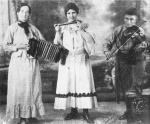 Mary Bolduc et ses co
Mary Bolduc et ses co
llègues jouant ... -
 Musique en feuille de
Musique en feuille de
la chanson « Ç... -
 Publicités annonçant
Publicités annonçant
les enregistrem...
Documents sonores
-
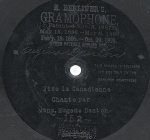 « Il a tant plus » interprétée par Gaston Saint-Jacques
« Il a tant plus » interprétée par Gaston Saint-Jacques
-
 « Lonlonla » par A. Fertinel (1903)
« Lonlonla » par A. Fertinel (1903)
-
 « Sa Muguette » interprétée par Hector Pellerin (1887-1953), décembre 1916
« Sa Muguette » interprétée par Hector Pellerin (1887-1953), décembre 1916
-
 « Un coin de ciel bleu = My blue heaven »
« Un coin de ciel bleu = My blue heaven »
-
 Au Clair De La Lune
Interpreter : Émile Loiseau .
Writer : Traditionnal.
Album : Une Simple Mélodie, 1903.
Au Clair De La Lune
Interpreter : Émile Loiseau .
Writer : Traditionnal.
Album : Une Simple Mélodie, 1903.
-
 Ça vous met la tête à l'envers
Interpreter : A. Fertinel.
Album : E. Berliner 1124, 1904.
Source : Bibliothèque et Archives Canada/Ça vous met la tête à l'envers/AMICUS.
Ça vous met la tête à l'envers
Interpreter : A. Fertinel.
Album : E. Berliner 1124, 1904.
Source : Bibliothèque et Archives Canada/Ça vous met la tête à l'envers/AMICUS.
-
 Mam'zelle Montréal [Baby Blue Eyes]
Interpreter : Gaston Saint-Jacques.
Writer : G. Jessel, W. Hirsch, J. Greer (traduction of Roméo Beaudry).
Album : Starr-Gennett 12076-A, 1923.
Mam'zelle Montréal [Baby Blue Eyes]
Interpreter : Gaston Saint-Jacques.
Writer : G. Jessel, W. Hirsch, J. Greer (traduction of Roméo Beaudry).
Album : Starr-Gennett 12076-A, 1923.
-
 Quand on a travaillé
Interpreter : Henri Cartal.
Writer : E. Berliner 1342, 1903.
Source : Bibliothèque et Archives Canada/Quand on a travaillé/AMICUS 31376342.
Quand on a travaillé
Interpreter : Henri Cartal.
Writer : E. Berliner 1342, 1903.
Source : Bibliothèque et Archives Canada/Quand on a travaillé/AMICUS 31376342.
Documents PDF
-
 L'enregistrement de disques à Montréal
L'enregistrement de disques à Montréal
-
 Nos artistes et l'enregistrement des records de phonographes
Nos artistes et l'enregistrement des records de phonographes
-
 Paroles de la chanson « My Blue Heaven »
Paroles de la chanson « My Blue Heaven »
-
 Paroles de la chanson « Un coin de ciel bleu »
Paroles de la chanson « Un coin de ciel bleu »
-
 Records STARR : Madame Bolduc et sa musique à bouche
Records STARR : Madame Bolduc et sa musique à bouche
Hyperliens
- Le Gramophone virtuel, de Bibliothèque et Archives Canada
- Site des enregistrements sonores de Bibliothèque et Archives

